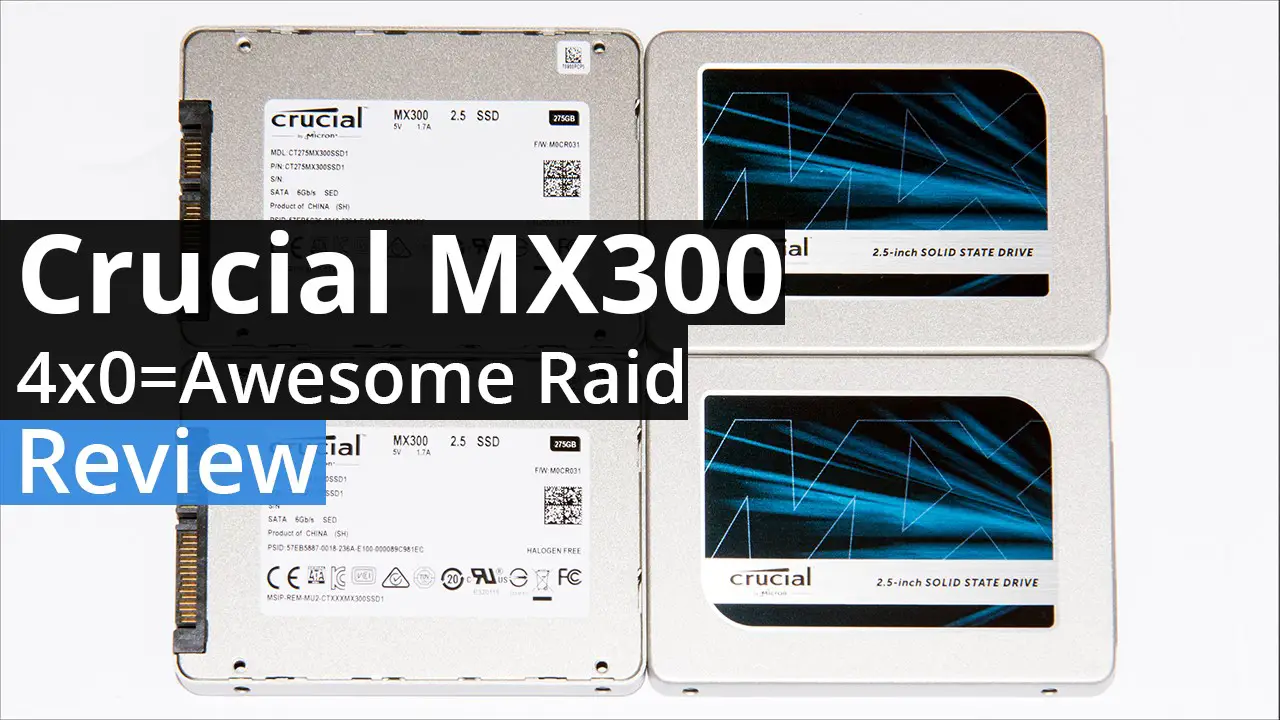The shipping container, accessories, and even the overall aesthetics of the MX300 275GB is the same as all the others capacity models. That is to say good and professional. If you want a more detailed look at these components, please check out any of our previous reviews on the MX300.
Also just as with all the previous MX300s, the 275GB capacity version does require a bit of explanation with regards to the oddball capacity rating. Basically, the new TLC 3D NAND has a density of 384Gbits per ‘layer’ (and yes even though this new NAND is built like an apartment building you can stack a layer upon top of another… or a fully-fledged apartment on top of another apartment) instead of 128Gbit (MLC) or 256GBit (TLC) like planar (2D) NAND in previous generations.
This does lead to some rather odd combinations. For example, the typical ‘240GB’ SSD is actually 256GB… but 256GB does not divide evenly into 48GB (384Gbits). So Crucial either had to used zero over-provisioning and use 5 layers (i.e. 240GB) or higher with 6 layers (288GB – the actual on-die amount this drive has though this extra 13GB is ‘over-provisioning’ that is not accessible by the system. Only the controller can access it and use these free blocks to replace bad blocks, wear leveling etc. etc.) Crucial decided to be generous and give us more rather than try and use 100% of the full on-die capacity -which would have been a bad idea. This explains why instead of 250GB, 500GB, 1TB or 2TB; MX300’s are 275GB, 550, 1050GB and 2050GB. Consider this unintended consequence of using mega-density NAND a nice little bonus.
It is also worth noting that the built in over-provisioning of the 275GB is precisely half of that of 550GB and is actually one of the lowest of all the MX300 series. To be precise 275GB is 13GB, 550GB is 26GB, 750GB is 18GB, 1050GB is 6GB, and the 2050GB is 14GB. Obviously 13GB is more than enough for a small sized drive. More importantly when you use four of them the OP becomes massive at 52GB or 8.67 times larger than a 1TB mx300 comes with! Needless to say, this capacity version really is meant for RAID environments!
Also like all others MX300s it is annoying that 6 layers is not easily divided into 4 channels. Instead, two of the four channels of the Marvell 88SS1074 4-channel controller will have only one layer and the other two will have two layers. Neither is optimal from a NAND interleaving point of view as this does roughly equate to better real world performance… but no modern, small capacity SSD has great NAND interleaving. Once again this capacity version really does benefit from RAID’ing…. as the more controllers involved with dealing I/O demands the better the performance – low NAND interleaving or not.
Now with that taken care of as you can see the MX300 275 actually makes use of a smaller half length PCB instead of the 3/4 found on most of the larger MX300s. Basically it uses the same PCB as the 550GB… which is fine. There is still plenty of room for the two NAND ICs, the single controller and the single RAM cache IC.
Now even though there is only two ICs there are actually six layers worth of NAND to populate the four channels of the controller. This is because these two NAND ICs are NW853 three layer ICs (144GB). We are unsure why Crucial felt the need to use 3 layer NAND ‘chips’ when they do make single and dual layer ONFi 4.0 677Mt/s ‘3D’ TLC NAND. Single layer ‘chips’ would run cooler than these two but three layers is not going to cause thermal issues either so this is mainly a moot point – it just offends our sense of sensibility.
Moving on we can see that Crucial may have halved the capacity of the onboard NAND but they have not messed with the RAM cache capacity. Instead they, just as with most of the MX300 series, uses a single 512MB LP-DDR3 Ram cache chip. That is a lot of cache for such a little drive and should help keep performance up during high I/O scenarios. Color us impressed!
To further boost performance the MX300 series also sets aside a portion of the NAND to use in what is best describe as pseudo-SLC mode. Much like smaller MX200s what the controller does is use an entire TLC cell in 1-bit mode… just as if it was SLC NAND. It then uses this space as a short-term cache for random writes and once the controller feels confident that this data is indeed needed for long term storage then – and only then – is it written to the TLC NAND portion of the drive.
Doing this is a lot gentler on the TLC NAND as the wear and tear of physically changing the cell from a 0 to 1 state is a lot less than with the usual six states a TLC cell has. This is a big reason why the MX300 2050GB can boast a 400TB Total Byte Written specification and excellent write performance. The only downside is that the capacity of the cell is only 1/3 of what it originally was. To put that another way to create a 20GB cache buffer requires sixty gigabytes worth TLC NAND. Also, unfortunately Crucial has hard set the buffer size and no longer uses a ‘floating’ capacity buffer like the MX200 series makes use of. This is because it did cause the occasional hiccup if the drive was quickly filled and a main priority of the MX300 series is performance consistency.
Another bonus of using a NAND based secondary cache buffer is the controller can quickly empty its RAM buffer and thus reduce the chance and amount of ‘in flight’ data becoming corrupted in the event of an unexpected power loss. To further reduce the chance of data loss the MX300 has a copious number of onboard capacitors that will allow the controller to do complete any writes that are ongoing, update its logs and then when the power is restored it can figure out what data in the SLC cache can be deleted and which needs to be transferred to the TLC portion of the NAND. The only data that will be lost is ‘in flight’ data stored in the RAM… but once again this amount is limited and since no Acknowledgement (‘Ack’) code is sent to the OS before it is written the NAND, the OS should not be expecting those changes to have been made. This doubling up of redundancy, triple if you include the ECC that also reduces uncorrectable data errors, means the MX300 may not have enterprise grade data loss protection but it is a lot closer than what most consumer grade drives do.













